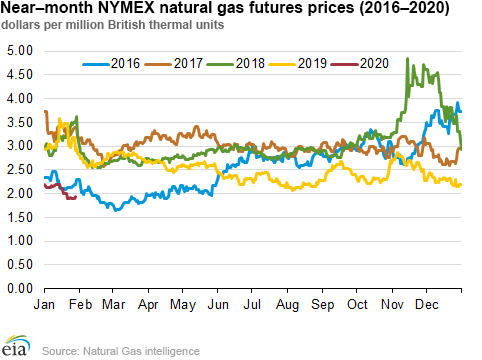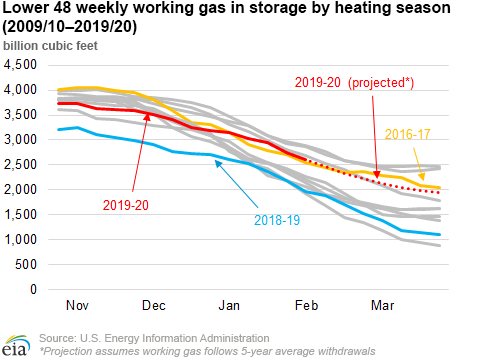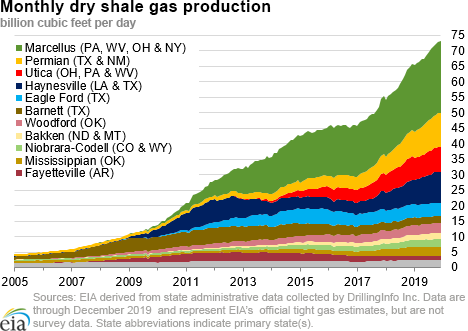In the News:
Natural gas prices fall to lowest level since 2016 and the lowest January price in 20 years
On Friday, January 24, the near-month natural gas Henry Hub futures price at the New York Mercantile Exchange closed at $1.893 per million British thermal units (MMBtu). This price was the lowest January closing price for the near-month contract since January 27, 1999, and the lowest near-month futures price since March 28, 2016, according to NGI data. In addition, the daily spot price at the Henry Hub national benchmark averaged $1.850/MMBtu on January 31, 2020, the second-lowest average price since May 27, 2016. Henry Hub spot prices have averaged between $1.820/MMBtu and $2.835/MMBtu this winter heating season (November 1, 2019– present), and the highest average price was set on November 7, 2019. Warm January weather, leading to reduced withdrawals from underground storage, combined with low nuclear outages and record natural gas production have depressed natural gas prices in future and spot markets.
According to National Oceanic and Atmospheric Administration data, January 2020 was the second-warmest January since 2000, which has limited withdrawals this heating season. Despite starting the 2019–20 heating season at the third-lowest level since 2009, by January 17, 2020, working natural gas storage levels have reached relatively high levels for mid-winter. EIA’s Lower 48 states’ natural gas stocks (storage levels) as of January 31, 2020, reflect a 199 billion cubic foot (Bcf) surplus to the five-year average. If working natural gas stocks follow the five-year average withdrawal rate for the remainder of the heating season, we will end the heating season at almost 2,000 Bcf in storage for the first time since 2017.
In addition to warmer weather, natural gas withdrawals have also been limited as a result of high levels of electric power generation from nuclear power plants. Although nuclear power plant outages tend to be relatively low in January, this January’s outages have been at multi-year lows for the month, moderating the demand for natural gas-fired generation so far this winter.
Natural gas also continues to be produced at near record levels, contributing to lower natural gas prices. Dry natural gas production in January averaged about 95.0 billion cubic feet per day (Bcf/d) according to IHS Markit data. January 2020 had the third-highest monthly production on record, lower than only November and December 2019. On average, dry natural gas production so far this heating season has averaged 95.5 Bcf/d, and if that average is maintained through the end of March, it would be 7.0 Bcf/d higher than last winter, which also set a production record.
Overview:
(For the week ending Wednesday, February 5, 2019)
- Natural gas spot prices fell at most locations this report week (Wednesday, January 29, to Wednesday, February 5). The Henry Hub spot price fell from $1.92/MMBtu last Wednesday to $1.85/MMBtu yesterday.
- At the New York Mercantile Exchange (Nymex), the February 2020 contract expired last Wednesday at $1.877/MMBtu. The March 2020 contract price remained unchanged Wednesday to Wednesday at $1.861/MMBtu. The price of the 12-month strip averaging March 2020 through February 2021 futures contracts declined 3¢/MMBtu to $2.147/MMBtu.
- The net withdrawal from working gas totaled 137 Bcf for the week ending January 31. Working natural gas stocks total 2,609 Bcf, which is 31% more than the year-ago level and 8% more than the five-year (2015–19) average for this week.
- The natural gas plant liquids composite price at Mont Belvieu, Texas, fell by 16¢/MMBtu, averaging $4.60/MMBtu for the week ending February 5. The prices of natural gasoline, ethane, butane, and isobutane fell by 5%, 2%, 6%, and 20%, respectively. The price of propane rose by 8%.
- According to Baker Hughes, for the week ending Tuesday, January 28, the natural gas rig count decreased by 3 to 112, the lowest level since October 2016. The number of oil-directed rigs fell by 1 to 675. The total rig count decreased by 4, and it now stands at 790.
Prices/Supply/Demand:
Prices fall across most of the country. This report week (Wednesday, January 29, to Wednesday, February 5), the Henry Hub spot price fell 7¢ from $1.92/MMBtu last Wednesday to $1.85/MMBtu yesterday. The price of $1.85/MMBtu on Friday, January 31, was the lowest January Henry Hub price since at least 2014. At the Chicago Citygate, the price decreased 6¢ from $1.80/MMBtu last Wednesday to $1.74/MMBtu yesterday, with a low of $1.67/MMBtu on Friday. Chicago prices rebounded slightly as a cold front approached the Midwest.
The price at PG&E Citygate in Northern California rose 6¢, up from $2.62/MMBtu last Wednesday to $2.68/MMBtu yesterday. PG&E Citygate saw a weekly high of $2.73/MMBtu on Tuesday, driven by the cold front that later moved into the Midwest. The price at SoCal Citygate in Southern California decreased 35¢ from $3.09/MMBtu last Wednesday to $2.74/MMBtu yesterday, with a high of $3.35/MMBtu on Monday.
Northeast prices fall. Prices generally fell in the Northeast as temperatures in the region increased throughout the week. At the Algonquin Citygate, which serves Boston-area consumers, the price went down 21¢ from $2.19/MMBtu last Wednesday to $1.98/MMBtu yesterday, with a low of $1.84/MMBtu on Monday. At the Transcontinental Pipeline Zone 6 trading point for New York City, the price decreased 20¢ from $1.93/MMBtu last Wednesday to $1.73/MMBtu yesterday, with a low of $1.70/MMBtu on Monday
The Tennessee Zone 4 Marcellus spot price decreased 3¢ from $1.54/MMBtu last Wednesday to $1.51/MMBtu yesterday. The price at Dominion South in southwest Pennsylvania rose 1¢ from $1.52/MMBtu last Wednesday to $1.53/MMBtu, a price that remained unchanged from Friday through Wednesday.
Waha prices narrow the discount to the Henry Hub with cold temperatures. The price at the Waha Hub in West Texas, which is located near Permian Basin production activities, averaged $0.34/MMBtu last Wednesday, $1.58/MMBtu lower than the Henry Hub price. Prices reached a weekly low of $0.09/MMBtu on Friday as a mechanical failure on Thursday at Transwestern Pipeline’s Station 4 Compressor Station in Klagetoh, Arizona, reduced takeaway capacity out of the Permian region. Prices later rebounded after the mechanical issue was fixed and below-freezing temperatures affected parts of North Texas. Yesterday, the price at the Waha Hub averaged $1.54/MMBtu, 31¢/MMBtu lower than the Henry Hub price. This is the closest the Waha Hub price has been to the Henry Hub price since January 2019.
Supply remains flat. According to data from IHS Markit, the average total supply of natural gas remained the same as in the previous report week, averaging 99.7 Bcf/d. Dry natural gas production remained constant week over week. Average net imports from Canada increased by 5% from last week.
Demand increases. Total U.S. consumption of natural gas rose by 2% compared with the previous report week, according to data from IHS Markit. Natural gas consumed for power generation declined by 2% week over week as temperatures in the Southeast generally warmed, reducing the need for space heating in the region. Industrial sector consumption increased by 2% week over week. In the residential and commercial sectors, consumption increased by 4% as a cold front moved across the western and central United States. Natural gas exports to Mexico decreased 4%.
U.S. liquefied natural gas (LNG) exports decrease week over week. Seventeen LNG vessels (eight from Sabine Pass, three each from Corpus Christi and Freeport, two from Cameron, and one from Cove Point) with a combined LNG-carrying capacity of 62 Bcf departed the United States between January 30 and February 5, 2020, according to shipping data compiled by Bloomberg.
Storage:
The net withdrawal from storage totaled 137 Bcf for the week ending January 31, compared with the five-year (2015–19) average net withdrawal of 143 Bcf and last year's net withdrawal of 228 Bcf during the same week. Working natural gas stocks totaled 2,609 Bcf, which is 199 Bcf more than the five-year average and 615 Bcf more than last year at this time.
According to The Desk survey of natural gas analysts, estimates of the weekly net change to working natural gas stocks ranged from a net withdrawal of 114 Bcf to 136 Bcf, with a median estimate of 130 Bcf.
The average rate of withdrawal from storage is 13% lower than the five-year average so far in the withdrawal season (November through March). If the rate of withdrawal from storage matched the five-year average of 11.9 Bcf/d for the remainder of the withdrawal season, the total inventory would be 1,896 Bcf on March 31, which is 199 Bcf higher than the five-year average of 1,697 Bcf for that time of year.
More storage data and analysis can be found on the Natural Gas Storage Dashboard and the Weekly Natural Gas Storage Report.
See also:
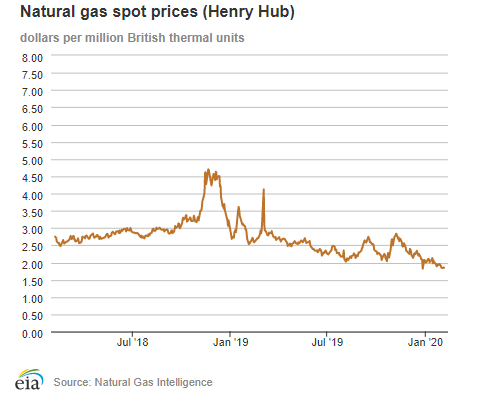
| Spot Prices ($/MMBtu) | Thu, 30-Jan |
Fri, 31-Jan |
Mon, 03-Feb |
Tue, 04-Feb |
Wed, 05-Feb |
|---|---|---|---|---|---|
| Henry Hub |
1.91 |
1.85 |
1.84 |
1.86 |
1.85 |
| New York |
1.89 |
1.73 |
1.70 |
1.78 |
1.73 |
| Chicago |
1.77 |
1.67 |
1.73 |
1.74 |
1.74 |
| Cal. Comp. Avg.* |
2.11 |
2.06 |
2.31 |
2.29 |
2.28 |
| Futures ($/MMBtu) | |||||
| March contract | 1.829 |
1.841 |
1.819 |
1.872 |
1.861 |
| April contract |
1.872 |
1.886 |
1.862 |
1.902 |
1.887 |
| *Avg. of NGI's reported prices for: Malin, PG&E Citygate, and Southern California Border Avg. | |||||
| Source: NGI's Daily Gas Price Index | |||||
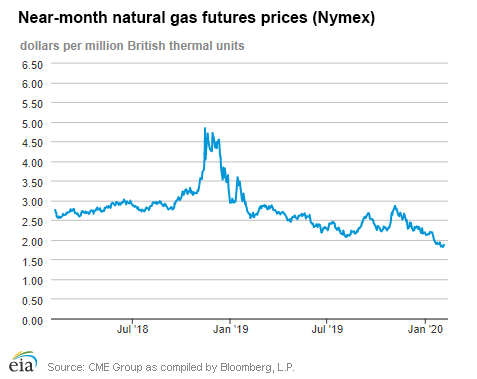
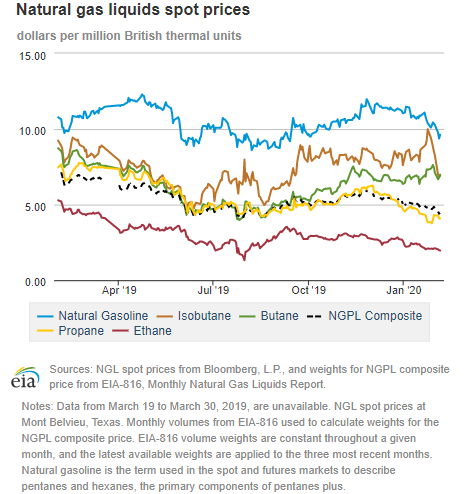
| U.S. natural gas supply - Gas Week: (1/30/20 - 2/5/20) | |||
|---|---|---|---|
Average daily values (Bcf/d): |
|||
this week |
last week |
last year |
|
| Marketed production | 106.7 |
106.6 |
99.7 |
| Dry production | 94.4 |
94.4 |
88.2 |
| Net Canada imports | 5.0 |
4.8 |
6.2 |
| LNG pipeline deliveries | 0.3 |
0.2 |
0.7 |
| Total supply | 99.7 |
99.4 |
95.1 |
|
Source: IHS Markit | |||
| U.S. natural gas consumption - Gas Week: (1/30/20 - 2/5/20) | |||
|---|---|---|---|
Average daily values (Bcf/d): |
|||
this week |
last week |
last year |
|
| U.S. consumption | 92.5 |
91.0 |
104.0 |
| Power | 27.9 |
28.6 |
28.2 |
| Industrial | 24.2 |
23.6 |
25.3 |
| Residential/commercial | 40.4 |
38.7 |
50.6 |
| Mexico exports | 5.4 |
5.7 |
5.0 |
| Pipeline fuel use/losses | 7.3 |
7.2 |
7.3 |
| LNG pipeline receipts | 9.3 |
9.2 |
3.4 |
| Total demand | 114.6 |
113.0 |
119.7 |
|
Source: IHS Markit | |||
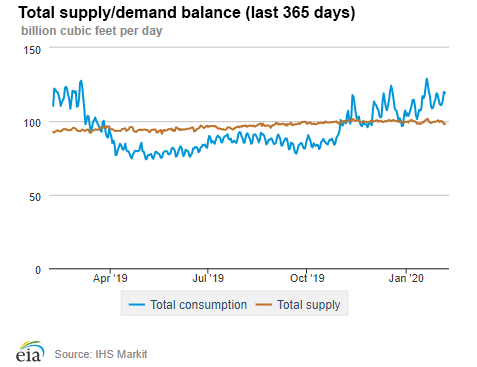
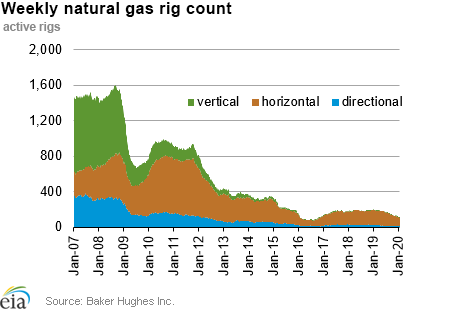
| Rigs | |||
|---|---|---|---|
Tue, January 28, 2020 |
Change from |
||
last week |
last year |
||
| Oil rigs | 675 |
-0.1% |
-20.3% |
| Natural gas rigs | 112 |
-2.6% |
-43.4% |
| Note: Excludes any miscellaneous rigs | |||
| Rig numbers by type | |||
|---|---|---|---|
Tue, January 28, 2020 |
Change from |
||
last week |
last year |
||
| Vertical | 34 |
-8.1% |
-46.0% |
| Horizontal | 711 |
0.1% |
-23.1% |
| Directional | 45 |
-4.3% |
-21.1% |
| Source: Baker Hughes Inc. | |||
| Working gas in underground storage | ||||
|---|---|---|---|---|
Stocks billion cubic feet (Bcf) |
||||
| Region | 2020-01-31 |
2020-01-24 |
change |
|
| East | 598 |
638 |
-40 |
|
| Midwest | 725 |
761 |
-36 |
|
| Mountain | 136 |
143 |
-7 |
|
| Pacific | 210 |
210 |
0 |
|
| South Central | 941 |
995 |
-54 |
|
| Total | 2,609 |
2,746 |
-137 |
|
|
Source: Form EIA-912, Weekly Underground Natural Gas Storage Report | ||||
| Working gas in underground storage | |||||
|---|---|---|---|---|---|
Historical comparisons |
|||||
Year ago (1/31/19) |
5-year average (2015-2019) |
||||
| Region | Stocks (Bcf) |
% change |
Stocks (Bcf) |
% change |
|
| East | 476 |
25.6 |
539 |
10.9 |
|
| Midwest | 534 |
35.8 |
636 |
14.0 |
|
| Mountain | 106 |
28.3 |
137 |
-0.7 |
|
| Pacific | 173 |
21.4 |
228 |
-7.9 |
|
| South Central | 703 |
33.9 |
869 |
8.3 |
|
| Total | 1,994 |
30.8 |
2,410 |
8.3 |
|
| Source: Form EIA-912, Weekly Underground Natural Gas Storage Report | |||||
| Temperature – heating & cooling degree days (week ending Jan 30) | ||||||||
|---|---|---|---|---|---|---|---|---|
HDD deviation from: |
CDD deviation from: |
|||||||
| Region | HDD Current |
normal |
last year |
CDD Current |
normal |
last year |
||
| New England | 210 |
-65 |
-37 |
0 |
0 |
0 |
||
| Middle Atlantic | 211 |
-52 |
-49 |
0 |
0 |
0 |
||
| E N Central | 229 |
-64 |
-146 |
0 |
0 |
0 |
||
| W N Central | 258 |
-51 |
-122 |
0 |
0 |
0 |
||
| South Atlantic | 152 |
-27 |
-33 |
4 |
-4 |
3 |
||
| E S Central | 157 |
-27 |
-52 |
0 |
-1 |
0 |
||
| W S Central | 107 |
-27 |
-40 |
0 |
-4 |
0 |
||
| Mountain | 189 |
-36 |
-28 |
0 |
-1 |
0 |
||
| Pacific | 93 |
-21 |
16 |
0 |
-1 |
0 |
||
| United States | 179 |
-43 |
-63 |
1 |
-1 |
1 |
||
|
Note: HDD = heating degree day; CDD = cooling degree day Source: National Oceanic and Atmospheric Administration | ||||||||
Average temperature (°F)
7-day mean ending Jan 30, 2020
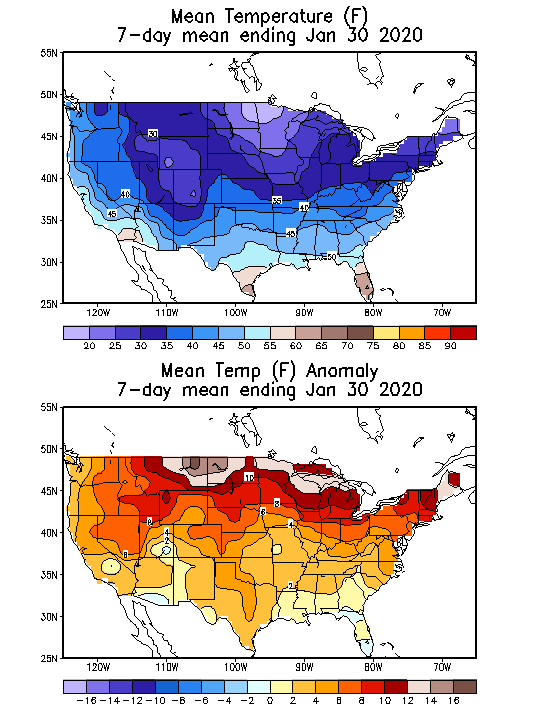
Source: National Oceanic and Atmospheric Administration
Deviation between average and normal (°F)
7-day mean ending Jan 30, 2020

Source: National Oceanic and Atmospheric Administration

